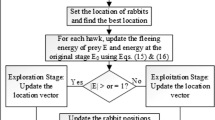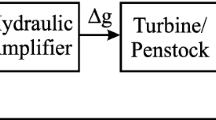Abstract
Due to the increased complexity and nonlinear nature of microgrid systems such as photovoltaic, wind-turbine fuel cell, and energy storage systems (PV/WT/FC/ESSs), load-frequency control has been a challenge. This paper employs a self-tuning controller based on the fuzzy logic to overcome parameter uncertainties of classic controllers, such as operation conditions, the change in the operating point of the microgrid, and the uncertainty of microgrid modeling. Furthermore, a combined fuzzy logic and fractional-order controller is used for load-frequency control of the off-grid microgrid with the influence of renewable resources because the latter controller benefits robust performance and enjoys a flexible structure. To reach a better operation for the proposed controller, a novel meta-heuristic whale algorithm has been used to optimally determine the input and output scale coefficients of the fuzzy controller and fractional orders of the fractional-order controller. The suggested approach is applied to a microgrid with a diesel generator, wind turbine, photovoltaic systems, and energy storage devices. The comparison made between the results of the proposed controller and those of the classic PID controller proves the superiority of the optimized fractional-order self-tuning fuzzy controller in terms of operation characteristics, response speed, and the reduction in frequency deviations against load variations.
Graphical abstract


















Similar content being viewed by others
Data availability
All data are fully available without restriction.
References
Antunes, A.R.D., 2014. Operation of microgrids in emergency conditions.
Asgari S, Suratgar AA, Kazemi M (2021) Feedforward fractional order PID load frequency control of microgrid using harmony search algorithm. Iran J Sci Technol Trans Electr Eng:1–13
Atangana A (2017) Fractal-fractional differentiation and integration: connecting fractal calculus and fractional calculus to predict complex system. Chaos, Solitons Fractals 102:396–406
Bevrani H, Feizi MR, Ataee S (2015) Robust frequency control in an islanded microgrid: H∞ and μ-synthesis approaches. IEEE Trans Smart Grid 7:706–717
Cafagna D (2007) Fractional calculus: a mathematical tool from the past for present engineers [Past and present]. IEEE Ind Electron Mag 1:35–40
Cai N, Mitra J, 2010. A decentralized control architecture for a microgrid with power electronic interfaces, in: North American Power Symposium 2010. IEEE, pp. 1–8.
Colet-Subirachs A, Ruiz-Alvarez A, Gomis-Bellmunt O, Alvarez-Cuevas-Figuerola F, Sudria-Andreu A (2011) Centralized and distributed active and reactive power control of a utility connected microgrid using IEC61850. IEEE Syst J 6:58–67
Gao Z, Liao X (2012) Improved Oustaloup approximation of fractional-order operators using adaptive chaotic particle swarm optimization. J Syst Eng Electron 23:145–153
Khooban M-H, Niknam T, Blaabjerg F, Davari P, Dragicevic T (2016) A robust adaptive load frequency control for micro-grids. ISA Trans 65:220–229
Khooban M-H, Dragicevic T, Blaabjerg F, Delimar M (2017) Shipboard microgrids: a novel approach to load frequency control. IEEE Trans Sustain Energy 9:843–852
Liu S, Wang X, Liu PX (2014) Impact of communication delays on secondary frequency control in an islanded microgrid. IEEE Trans Ind Electron 62:2021–2031
Luo ZJ, Wang JR (2017) Study on iterative learning control for Riemann–Liouville type fractional–order systems. Differ Equations Appl 9:123–139
Mirjalili S, Lewis A (2016) The whale optimization algorithm. Adv Eng Softw 95:51–67
Naderipour A, Abdul-Malek Z, Miveh M, Hadidian Moghaddam M, Kalam A, Gandoman F (2018) A harmonic compensation strategy in a grid-connected photovoltaic system using zero-sequence control. Energies 11:2629
Naderipour A, Abdul-Malek Z, Nowdeh SA, Kamyab H, Ramtin AR, Shahrokhi S, Klemeš JJ (2021) Comparative evaluation of hybrid photovoltaic, wind, tidal and fuel cell clean system design for different regions with remote application considering cost. J Clean Prod 283:124207. https://doi.org/10.1016/j.jclepro.2020.124207
Osika O, 2005. Stability of micro-grids and inverter-dominated grids with high share of decentralised sources. Kassel university press
Oustaloup A, Levron F, Mathieu B, Nanot FM (2000) Frequency-band complex noninteger differentiator: characterization and synthesis. IEEE Trans Circuits Syst I Fundam Theory Appl 47:25–39
Overholt PN (2002) Consortium for Electric Reliability Technology Research under competition, in: IEEE Power Engineering Society Summer Meeting. IEEE:1716–1717
Pahasa J, Ngamroo I (2014) Coordinated control of wind turbine blade pitch angle and PHEVs using MPCs for load frequency control of microgrid. IEEE Syst J 10:97–105
Pan I, Das S (2014) Kriging based surrogate modeling for fractional order control of microgrids. IEEE Trans. Smart Grid 6:36–44
Pedrasa MA, Spooner T, 2006. A survey of techniques used to control microgrid generation and storage during island operation, in: Proceedings of the 2006 Australasian Universities Power Engineering Conference (AUPEC’06). pp. 1–6
Podlubny I (1999) Fractional-order systems and PI/sup/spl lambda//D/sup/spl mu//-controllers. IEEE Trans Automat Contr 44:208–214
Ramirez D, Beites LF, Blazquez F, Ballesteros JC (2008) Distributed generation system with PEM fuel cell for electrical power quality improvement. Int. J. Hydrogen Energy 33:4433–4443
Rasoanarivo I, Sargos F-M, 2013. Multi-objective analysis for designing and controlling micro-grids under multi-control with PID, MHCC and FOPID controllers, in: 2013 IEEE Industry Applications Society Annual Meeting. IEEE, pp. 1–8
Schwaegerl, C., Lopes, J.P., Vasiljevska, J., Ferreira, R., Moreira, C., Madureira, A., 2009. Report on the technical, social, economic, and environmental benefits provided by microgrids on power system operation-Annex 5. Available More Microgrids website http//www. microgrids. eu/documents.
Sivalingam R, Chinnamuthu S, Dash SS (2017) A modified whale optimization algorithm-based adaptive fuzzy logic PID controller for load frequency control of autonomous power generation systems. Automatika 58:410–421
Vafamand N, Khooban MH, Dragičević T, Blaabjerg F (2018) Networked fuzzy predictive control of power buffers for dynamic stabilization of DC microgrids. IEEE Trans Ind Electron 66:1356–1362
Yang J, Zeng Z, Tang Y, Yan J, He H, Wu Y (2015) Load frequency control in isolated micro-grids with electrical vehicles based on multivariable generalized predictive theory. Energies 8:2145–2164
Yeşil E, Güzelkaya M, Eksin İ (2004) Self tuning fuzzy PID type load and frequency controller. Energy Convers Manag 45:377–390
Zhang Z, Huang X, Jiang J, Wub B (2006) Dynamic characteristics of a micro-grid involving a PEM fuel cell power module. In: 2006 IEEE International Symposium on Industrial Electronics. IEEE, pp 2030–2034
Zheng W, Luo Y, Pi Y, Chen Y (2018) Improved frequency-domain design method for the fractional order proportional–integral–derivative controller optimal design: a case study of permanent magnet synchronous motor speed control. IET Control Theory Appl 12:2478–2487
Funding
The authors gratefully acknowledge financial support from the Universiti Teknologi Malaysia (Post-Doctoral Fellowship Scheme grant 05E09, and RUG grants 01M44, 02M18, 05G88, 4B482) and Post-Doctoral fellow (Teaching & Learning) Scheme under MJIIT-UTM.
Author information
Authors and Affiliations
Contributions
Amirreza Naderipour: Writing—original draft, conceptualization, methodology. Aldrin Abdullaha: Supervision. Iraj Faraji Davoodkhani: Codding, software. Zulkurnain Abdul-Malek: validation. Hesam Kamyab: Writing—reviewing and editing.
Corresponding author
Ethics declarations
Ethical approval, consent to participate, and consent to publish are not applicable.
Competing interests
The authors declare no competing interests.
Additional information
Responsible Editor: Philippe Garrigues
Publisher’s note
Springer Nature remains neutral with regard to jurisdictional claims in published maps and institutional affiliations.
Rights and permissions
About this article
Cite this article
Naderipour, A., Abdul-Malek, Z., Davoodkhani, I.F. et al. Load-frequency control in an islanded microgrid PV/WT/FC/ESS using an optimal self-tuning fractional-order fuzzy controller. Environ Sci Pollut Res 30, 71677–71688 (2023). https://doi.org/10.1007/s11356-021-14799-1
Received:
Accepted:
Published:
Issue Date:
DOI: https://doi.org/10.1007/s11356-021-14799-1




